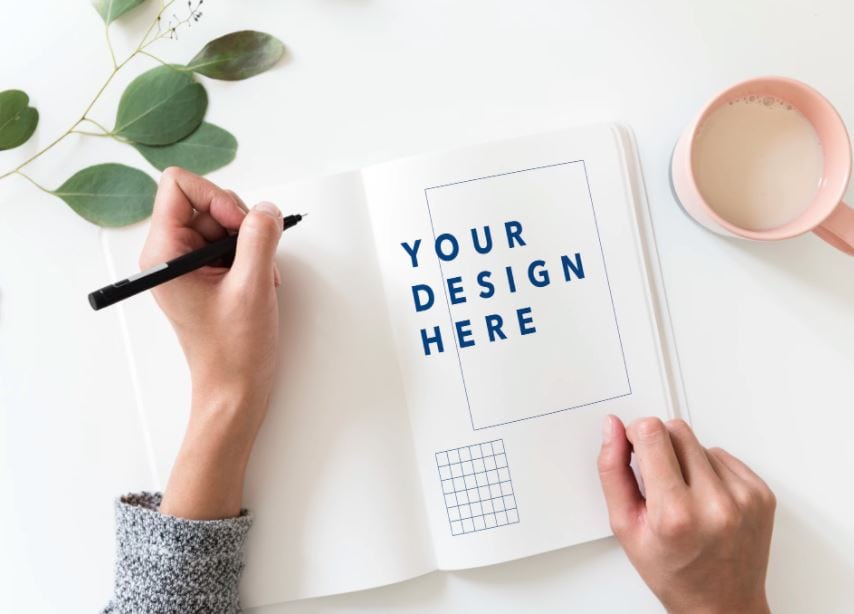When you launch a business, a freelance career, or any other project that requires any semblance of marketing effort, it will probably take you all of three seconds to realize that somewhere along the line you’re going to need some graphic design. Whether it’s your logo, your website banner, your business cards, or simply social media posts — your biz cannot live on copy alone.
And when you come to this realization, assuming you are not already a graphic designer by profession, you may find yourself dismayed. Because graphic design can be painfully expensive, and for good reason; graphic designers go through a lot of training and build up their portfolio over years of hard work in order to garner that kind of lucrative expertise. If you can afford to have one on your team, do; it’s an incredible investment. But for those of us just starting out, that’s a pretty big ‘if.’
What if you’re at zero budget? Or the tiny budget you do have has been triaged to a few bare bone essentials? In that case, you’re left with only one option: You’ve got to design this stuff yourself. As you move forward, remember that not all imagery is created equal. This will be the face of your company, and new clients will inevitably judge it as such — which means a misstep in design could easily be the death of your new adventure.
Don’t get me wrong; that doesn’t mean you shouldn’t go for it! It just means you need to keep a few key points in mind as you begin.
- Keep it simple. There’s nothing that will make an amateur stick out more than too much flair. Have you ever been to a website that was just so jarring and messy you clicked away immediately? Or been handed a business card that seemed weirdly incongruent with the business attached to it? Not everyone is a designer, but these days, everyone has been exposed to enough design that we can easily spot the frauds. We’re blind to our own failures, however, and too often I see folks who think the website they designed is fantastic — when to everyone else’s eye, it’s a mess. They’re trying too hard. Let go of your fancy, lofty design goals, and just keep it simple. Minimalism is hip these days for a reason; the less clutter you have, the more effortless your design looks. And you want it to look effortless. You don’t want anyone to actually notice design; that would mean they’re noticing incongruences. Don’t opt for the overly curly fonts, don’t use a thousand and one different colors, and don’t try to make the five buttons on your website into perfectly spaced octagonal robot ear replicas. Not only will your work most likely come across as campy and unprofessional, you’ll waste yourself a whole lot of time. At the end of the day, remember — you’re not a designer. You’ve got a business to run, and that should take up more of your time than design.
- Keep it consistent. A simple way to save yourself time and heartache when moving forward with a design plan is to pick a few key elements, and then stick to those for the rest of the foreseeable future. Have a set of fonts that you always use — and by set, I mean two or three, not seven. Pick a color scheme that resonates with you and your brand; then, every time you go to create some design content, stick to that color scheme. Don’t experiment! This is your business, not an after-hours art class. You’ve got a brand, a style, a voice; make sure your design is consistent with that. This will obviously save you time, but it will also help to make your brand more recognizable. When you’re using the same elements in your work, consumers will start to recognize you; they’ll associate those elements with your brand, which makes your marketing job that much easier.
- When in doubt, find great imagery. If you’ve got a space that needs a visual — say, a website header space, or an email newsletter — ask yourself if an image will work. Unsplash is a treasure-trove of free, professional-grade imagery, and one of those photos can be often used just as easily as the fancy header that took you three hours to design. Remember number one: Keep it simple. You’ve got a lot of work to do, and you don’t need to spend half your time in graphic design when a premade, free image will do just as well. Lean into your strengths; be realistic with your time. Too many business owners miss out on excellence because they’re too obsessive with perfection; if a photo will do, use a photo.
- Use free tools. If you can take a class on InDesign and master that, more power to you — but often those professional tools cost a bit too much in time and money to master. Thanks to the internet, there is an abundance of free tools out there to help you with your design needs. Both Squarespace and Wix have free logo design tools for those who use their site builders. If you order business cards with Moo or Vistaprint, there are a whole pile of premade designs to choose from; don’t stress about making it yourself. Use what’s available! Just tweak it a little to make it unique, and then be done with it. Add typography to images with PicLab or Over (as long as you keep the fonts consistent, right?), and edit your own photos with A Color Story. And, if you have the time to jump in and learn the tools, Canva has a pretty sweet free plan for amateur designers. But yet again, all of this brings us back to number one: keep it simple. Let go of the perfect idea you have in your head, and use these free tools to make something that works.
- Never, ever EVER ask a designer for free work. Seriously. Don’t do it. And no, offering ‘exposure’ in exchange for free labor is not an appropriate payment, unless you already have a huge following and plan to actually promote them to said following. If you’re just starting out and have a mailing list of 3 people (your spouse and your parents), that does not count as ‘exposure.’ Look, I get it; you see your friend with that fancy graphic design degree churning out incredible work like it’s nothing. It took her less than an hour to design some guys’ logo! She’s your friend — why wouldn’t she do the same for you? Well, the thing is, what you’re not seeing are the thousands of hours that went into her learning how to do that so efficiently, the work she put into the back-and-forth emailing with that client, the investment she had to make to buy the software to make that logo, the dollars she spent keeping up her own skill set and toolbox — you just saw the tip of the iceberg. Do not ask for free work. Trade is occasionally acceptable, as long as you actually have something of legitimate value to offer in return. If not, stick to DIY, and save up for the day when you’ll be able to hire your friend at a reasonable rate.
 Subscribe now to receive our upcoming Spring issue — free!
Subscribe now to receive our upcoming Spring issue — free!







